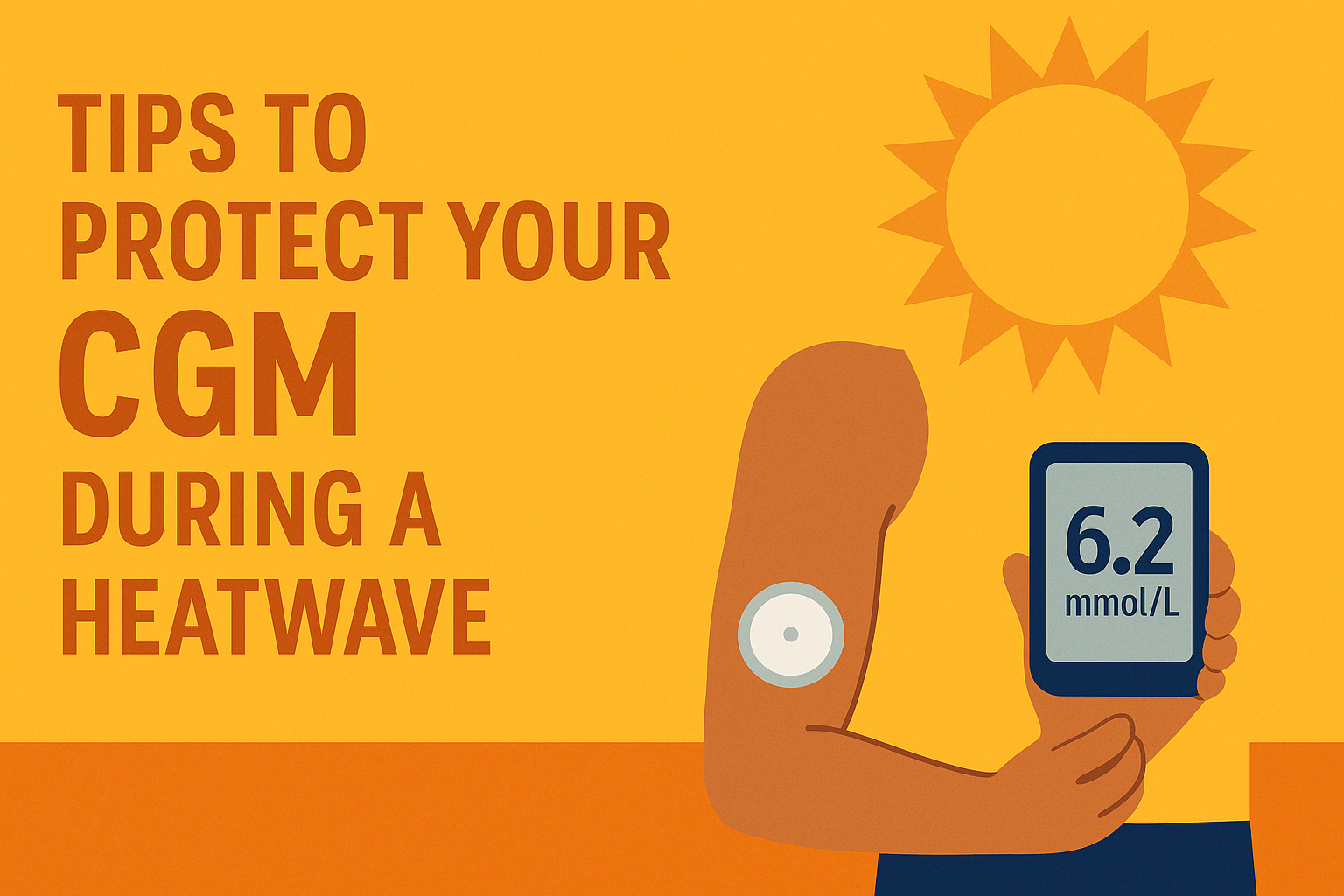| Blogs and publications on this website are independent of any involvement by medtech companies or diabetes related charities. To ensure there is no bias, we do not accept any products, freebies or other material from any medtech provider. All materials are copyright©️Love My Libre Ltd. |
***
Wintery weather adds another factor for those with diabetes to the ever-destabilising balancing act of glucose level management.
In this blog we consider the effects of cold temperatures on our glucose levels and what we could be doing to take care of your medical supplies, physical self and wellbeing over the winter months.
Cold Temperatures
Core body temperature is closely associated to our metabolism and as diabetes upsets the natural processes of converting fuel to energy, this often leads to a PWD (person with diabetes) experiencing more frequent episodes of sweating, shivering, and shaking than those who do not have the condition.
It’s quite normal for a PWD to feel the cold, as well as numbness in parts of the body from time to time, particularly the arms and legs.
When nerves have suffered damage due to diabetes (peripheral neuropathy) there will be a loss of sensation in areas of the body and PWD with this ‘complication’ will typically have difficulty regulating their temperature.
FACT: Glucose levels are likely to be very different in winter compared to summer and PWD tend to have a higher HbA1c level in colder months.
💛💛💛
Tips for looking after your diabetes supplies & equipment
Below we have detailed our top 10 suggestions for surviving the winter with diabetes. If you have any other suggestions to share please do comment at the end of this page.
1. Keep your supplies at the correct temperature
Insulin can generally be left at room temperature for around a month in normal conditions. However, as the outside temperature drops it may be exposed to lower temperatures without users even realising or considering where it’s being left.
For instance, insulin or other temperature-sensitive medical supplies may be at risk in a cold car. Remember, the longer the exposure to extreme temperatures, the less effective insulin becomes. It's not recommended to use insulin that has been frozen as this is likely to have degraded and won't work correctly.
If you're carrying around extra insulin while out in particularly cold conditions it may be advisable to keep insulin pens or vials in an insulated bag, for example a Frio case or Breezy pack.
***
2. Protect your sensor and diabetes equipment
If you're out in cold conditions it's important to consider where you are wearing your sensor and pump (if worn). these can be adversely affected if exposed to cold temperatures.
Wearing an armband that covers the sensor, such as a Libreband for FreeStyle Libre, can help to keep your sensor warm, as well as protected from knocks. Librebands will provide protection under thick jumpers and coats and it will still be possible to scan to see glucose levels.
See our range of Librebands here or Dexbands here.
If you use an insulin pump, it is advisable to wear this close to the body and in winter ensure it's covered by thick clothes to avoid exposure in cold conditions.
Other equipment such as glucose meters and test strips may also need to be protected from the cold especially if left in rooms that aren't heated.
***
3. Boost your vaccine protection

Get a flu jab
Those with diabetes are always encouraged to get a flu vaccine annually as we can suffer more than non-diabetics if getting ill over the ‘flu season’. It’s not a guarantee that we won’t get flu but it does help to reduce the symptoms and severity if we do.
Having a flu vaccination has also been shown to be associated with reduced hospitalizations from a worsening condition such as diabetes.
Unfortunately, we are also more likely to pick up a cold or another virus in the winter months. The reason for this is generally because viruses can ‘hang around’ longer in cold air, some even thrive in cold temperatures.
Have the Covid-19 vaccine
Having Covid can really affect blood glucose levels and make management of the condition very tricky. Generally, you will need more insulin as the virus causes an increase in glucose levels.
Priority for the Covid jab is given to those with type 1 diabetes and PWD are strongly encouraged to take up the offer of the vaccine and boosters.
Check here for the priority list used for the Covid-19 vaccination, by the NHS.
***
4. Pay attention to your feet

You’re probably aware that with diabetes you are more likely to develop feet problems which can have very significant consequences. Keeping a check on your feet is very important and ideally it should be a part of a PWD’s daily routine.
In winter the skin on the bottom of your feet can dry out and may be vulnerable to cracking, in turn increasing the likelihood of infection. If you have peripheral neuropathy or poor circulation you may also not feel the cold at your extremities and this could have serious health consequences.
You can read our blog with lots of tips for caring for your feet here.
***
5. Top up with vitamins and minerals

Vitamin D supplements
Current UK government advice is that everyone should consider taking vitamin D supplements during the colder seasons, as most people will not get enough of this from natural sunlight. The recommended timeframe is from around September to April.
From April to September, spending time outdoors will usually give the body sufficient exposure to sunlight when outdoors to create the needed amount of vitamin D.
Although Vitamin D is found in certain foods e.g. oily fish, red meat, liver and egg yolks, it is get sufficient from food alone and therefore a daily supplement of vitamin D may be beneficial.
Iron supplements
Iron enables the body to transfer nutrients and heat around the body and without it you may feel colder at the extremities ie. hands and feet. It also affects the thyroid which can make you feel colder too.
Keeping your fingers warm will help when carrying out finger prick tests as the blood will flow more easily and give a more accurate glucose level reading.
6. Stay active
Exercise for type 1s has generally been approched with caution with the focus on avoiding hypos. However, a recent study has suggested that it is safe for T1Ds to do moderate exercise when blood glucose is over 10.6mmol/L. At this level there is minimal risk of having a hypo.
The study also suggests that exercise can be used more effectively than correction doses to lower glucose levels when out of range.
It is suggested that 10 minutes of exercise will reduce glucose levels by around 2mmol/L and that this effect will be seen in 10-20 minutes rather than 2-3 hours for a correction dose to properly take effect.
Being active helps to improve insulin sensitivity and the circulation of blood around the body. Adults are recommended to exercise or be moderately active for 30 minutes per day.
Tip: Building muscle can help to improve a person's metabolism and make a difference to core body temperature, boosting immunity.
***
7. Take time for your wellbeing

Cold and dark days over the winter period can have an indirect effect on wellbeing and this is often linked to a rise in mental health issues.
Those with diabetes can be particularly affected as feelings of loneliness and the burden of managing the condition can grow and dwell in minds.
Some of my suggestions for dealing with how you feel when diabetes is causing stress and anxiety are:
-
Take time out for yourself and do an activity that you enjoy. The growth and popularity of colouring books for mindfulness addresses this suggestion, but it could be all sorts of actions and the best ones are those that absorb your attention away from the day-to-day. The important thing is that it's specific to you!
-
Find someone to listen, and I mean really listen - not just have a chat, but someone that is active in listening to what you have to say. You may not need to unburden your diabetes issues on them, it's about feeling heard for whatever you need to say!
-
Find others in a forum or local group that you can share stories with or get advice and that know what you're experiencing. You will find that you're not alone with your feelings.
Details of some resources that can support you with well-being are listed here.
***
8. Have a plan for eating & drinking over Christmas

Christmas is often a time of indulgence and it can be difficult to manage glucose levels where food is tempting and does not necessarily follow the usual ritual of 3 meals a day - in fact, quite often the timings will be erratic.
Unpredictability can play havoc with our levels and knowing when and how much insulin to inject. Add to this, the fact that many people tend to drink more alcohol over the Christmas period and this makes diabetes management even more tricky.
One way to approach this is to plan ahead and be disciplined. If you know what's likely to be served you could check the carb content in advance. We suggest looking up the dishes on Carbs & Cals or MyFitnessPal. Bear in mind that you may also need to split doses or take extra insulin to correct levels, taking account of the possibilities of 'stacking' which can often cause unforeseen swings in levels.
You can also find out about Christmas drinks in our blog: Tipples for a Type 1 at Christmas. Click here.
***
***
9. Follow Sick Day Rules
If you pick up any illness, it almost goes without saying that you should be following your 'Sick Day Rules'.
The NHS Guidance for Sick Day Rules are linked here but you may have guidance from your own diabetes team and/or your own individual plan for how you deal with your diabetes management when ill.
In general, when the body is coping with an illness then it is less effective at other functions. Insulin resistance is likely to increase and glucose levels can rise as a result. Monitoring levels is more so important.
If you have a temperature, another priority should be to keep hydrated as this often leads to dehydration.
For PWD wearing a FreeStyle Libre, you should ensure that you scan more often so to follow trends and take appropriate action. If you have another CGM remember to check your levels more regularly throughout the day. If you feel too unwell or spend lots of time sleeping because of illness, maybe ask someone else to keep an eye on your glucose levels. If you don't already have anyone as a "follower" this could be an option you should consider.
If in doubt with your diabetes management while ill, get in touch with your diabetes team.
BE PREPARED: Over the winter months it's a good idea to ensure you are well-stocked with extra hypo treats and emergency glucogen etc.
Steer clear of illness
For those with diabetes, being more susceptible to illnesses can mean that it's best to avoid others at certain times. If someone close to you has a cold, flu or other virus it may be best not to be sociable, certainly while they remain infectious. But this may be a difficult ask over the Christmas period as meeting and spending time with family and friends is one of the most enjoyable aspects of the festive season.
***
10. Sleep well

It’s no secret that getting a good night’s sleep is a key factor to our health and wellbeing. And the contradictory is also true in that a lack of sleep or poor-quality sleep can affect us physically, mentally and emotionally. For those with diabetes, getting less sleep than we need can negatively affect our insulin sensitivity quite markedly, making us more insulin resistant.
The knock-on effect is that we need to ‘correct’ our levels and inject more, more often. We are more likely to experience spikes in our glucose levels, riding the highs and lows of the diabetes rollercoaster. However, improving our sleep can directly affect those levels and our time in range.
This generally means getting between 7 and 9 hours of sleep every night, including enough deep sleep, which according to eecent scientific studies is linked with regulating the amount of glucose in the blood.
I think almost everyone with diabetes knows this can prove tricky and sleep can often be broken for all sorts of diabetes-related reasons and more since the use of Libre and other CGM. Alarms!
TIP: Try to wind down around 1/2 hour before going to sleep. Ideally this time should be spent away from a screen or other white light.
Links
Frio: https://friouk.com
Breezy: https://www.breezypacks.com
MyFitnessPal: https://www.myfitnesspal.com
💛💛💛
Disclaimer
Content here and on our website www.lovemylibre.com does not constitute medical advice or replace the relationship between you and healthcare professionals nor the advice you receive from them.
The author of this blog has type 1 diabetes and uses the FreeStyle Libre 2 which is provided on NHS prescription. We do not have any affiliate relationship with Abbott FreeStyle Libre or any medtech provider. All trademarks are the intellectual property of their respective owners.







Leave a comment (all fields required). Please note, we are unable to respond to individual comments posted here.